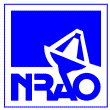
National Radio Astronomy Observatory
P.O. Box O
Socorro, NM 87801
http://www.nrao.edu
EMBARGOED For Release: 2:00 p.m., EST, Monday, Feb. 18, 2008
Contact:
Dave Finley, Public Information Officer
Socorro, NM
(575) 835-7302
dfinley@nrao.edu
An international project to make the world's most productive ground-based telescope 10 times more capable has reached its halfway mark and is on schedule to provide astronomers with an extremely powerful new tool for exploring the Universe. The National Science Foundation's Very Large Array (VLA) radio telescope now has half of its giant, 230-ton dish antennas converted to use new, state-of-the-art digital electronics to replace analog equipment that has served since the facility's construction during the 1970s.
"We're taking a facility that has made landmark discoveries in astronomy for three decades and making it 10 times more powerful, at a cost that's a fraction of its total value, by replacing outdated technology with modern equipment," said Mark McKinnon, project manager for the Expanded VLA (EVLA). Rick Perley, EVLA project scientist, added: "When completed in 2012, the EVLA will be 10 times more sensitive, cover more frequencies, and provide far greater analysis capabilities than the current VLA. In addition, it will be much simpler to use, making its power available to a wider range of scientists."
The EVLA will give scientists new power and flexibility to meet the numerous challenges of 21st-Century astrophysics. The increased sensitivity will reveal the earliest epochs of galaxy formation, back to within a billion years of the Big Bang, or 93 percent of the look-back time to the beginning of the Universe. It will have the resolution to peer deep into the dustiest star-forming clouds, imaging protoplanetary disks around young stars on scales approaching that of the formation of terrestrial planets. The EVLA will provide unique capabilities to study magnetic fields in the Universe, to image regions near massive black holes, and to systematically track changes in transient objects such as supernovae and fast-moving jets from massive, compact objects such as neutron stars and black holes.
Authorized by Congress in 1972, the VLA was constructed during the 1970s and dedicated in 1980. Astronomers began using it for research even before its completion. To date, nearly 2,500 scientists from around the world have used the VLA for more than 13,000 observing projects. More than 200 Ph.D dissertations have been based on data obtained from VLA observations. The VLA's discoveries have ranged from finding water ice on Mercury, the closest planet to the Sun, to revealing details of the complex region surrounding the black hole at the core of our own Milky Way Galaxy, to providing surprising evidence that a distant galaxy had already formed and produced stars prolifically less than a billion years after the Big Bang.
Half, or fourteen, of the VLA's inventory of 28, 25-meter-diameter dish antennas now have been converted to the new, digital configuration. The antennas collect faint radio waves emitted by celestial objects. Data from all the antennas are brought to a central, special-purpose computing machine, called a correlator, to be combined into a form that allows scientists to produce detailed, high-quality images of the astronomical objects under investigation.
This entire system for collecting, transmitting and analyzing the cosmic radio signals is being replaced for the EVLA. New, more sensitive radio receivers will cover the entire frequency range of 1-50 GHz. A 1970s-era waveguide system gives way to a modern, fiber-optic system that dramatically increases the amount of data that can be delivered from the antenna to the correlator. Finally, a new, state-of-the-art correlator -- a special-purpose supercomputer -- is being built by Canadian scientists and engineers. This correlator will easily handle the increased data flow, offers much greater observing flexibility, and provides vastly expanded capabilities for analyzing the data to gain scientific insight about the astronomical objects.
"We're leapfrogging several generations of technological progress to make the EVLA a completely modern, 21st-Century scientific facility," said Fred K.Y. Lo, NRAO Director.
Construction work on the EVLA began in 2001. The project costs $93.75 million in U.S. dollars -- $58.7 million in new direct funding from the National Science Foundation, $1.75 million from Mexico, $17 million from Canada in the form of the new correlator, and $16.3 million in the form of labor from existing staff at the NRAO. The current value of the VLA infrastructure on which the EVLA is being built is estimated at $300 million.
"The EVLA project is giving us 10 times the VLA's capability at one-third the cost of the current facility," McKinnon pointed out.
To provide the improved scientific capabilities, the EVLA will boast some impressive technical feats. For example, the fiber-optic data transmission system will carry as much information instantaneously as the entire current U.S. internet. The EVLA receiving system will be so sensitive that it could detect the weak radio transmission from a cell phone at the distance of Jupiter -- half a billion miles away.
The National Radio Astronomy Observatory is a facility of the National Science Foundation, operated under cooperative agreement by Associated Universities, Inc.